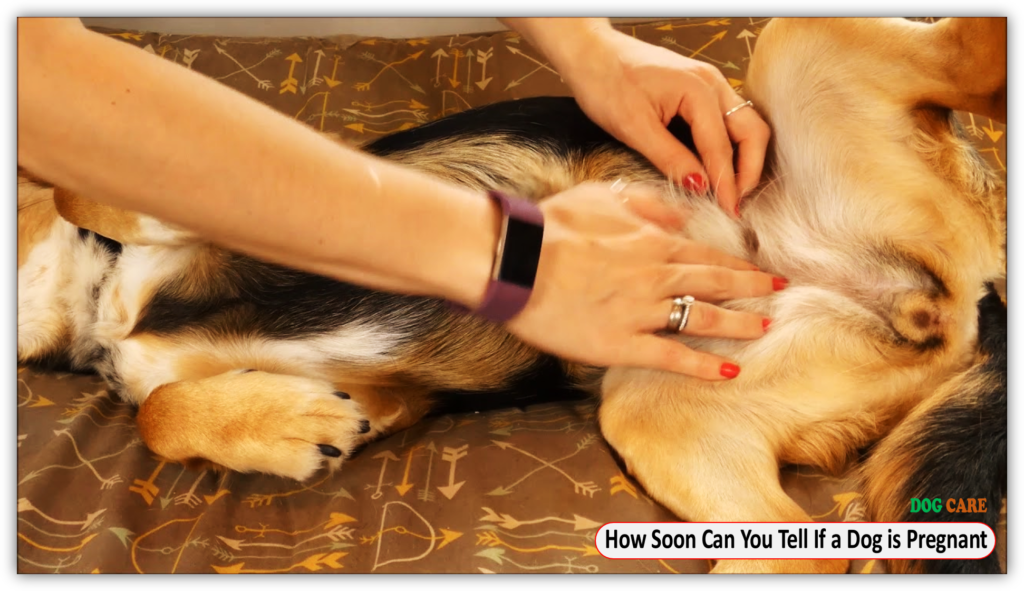How Soon Can You Tell If a Dog is Pregnant – A dog’s pregnancy can be determined by a veterinarian through ultrasound or hormone testing within 3-4 weeks. Dog owners often wonder how soon they can find out if their dog is pregnant.
The good news is that determining canine pregnancy can be done as early as 3-4 weeks after mating. While it may not be obvious to the average person, a veterinarian can use ultrasound or hormone testing to accurately detect pregnancy.
This can be important information for dog owners who need to be prepared for the arrival of puppies and want to ensure the health and well-being of their pets. Understanding the early signs of pregnancy in dogs can help owners provide the necessary care and support for their pregnant canine companions. We will explore the various methods used by veterinarians to determine if a dog is pregnant and the signs to look out for.

Signs Of Pregnancy In Dogs
When it comes to breeding dogs, it’s essential to know the signs of pregnancy so you can provide the necessary care and support for your furry friend. While a veterinary examination is the only foolproof method to determine pregnancy, there are several signs you can look out for. In this article, we will discuss the physical and behavioral changes that can indicate pregnancy in dogs.
Physical Changes
One of the earliest signs of pregnancy in dogs is visible physical changes in their body. These changes can occur as early as 25-30 days after mating and may vary depending on the breed and individual dog.
- Increase in nipple size and color: The nipples of pregnant dogs often become enlarged and may darken in color. This change is more noticeable in dogs that have lighter-colored fur.
- Swollen abdomen: As the pregnancy progresses, you may notice a slight bulge in your dog’s belly. This is a result of the growing puppies and the expansion of the uterus.
- Weight gain: Pregnant dogs may start to gain weight, especially around their abdomen area.
- Changes in appetite: Some pregnant dogs may develop a decreased appetite during the early stages of pregnancy, while others may experience an increased appetite.
Behavioral Changes
In addition to physical changes, pregnant dogs may also exhibit behavioral changes that can indicate their pregnancy. These changes can be subtle and vary from dog to dog.
- Increased nesting behavior: A pregnant dog may start seeking out a comfortable and secure place to create a nest for her upcoming puppies.
- Decreased activity level: As pregnancy progresses, some dogs may become less energetic and prefer to rest more often.
- Changes in temperament: Pregnant dogs may display changes in their behavior, such as being more affectionate, clingy, or even more protective of their territory.
- Enlarged mammary glands: Along with the physical changes in the nipples, pregnant dogs may also have visibly larger mammary glands as their body prepares for milk production.
While these signs can indicate pregnancy, it’s important to note that they are not definitive proof. Veterinary confirmation through a physical examination, ultrasound, or blood test is the only way to confirm if your dog is pregnant. If you suspect your dog may be pregnant, it’s recommended to consult with your veterinarian for proper care and guidance.
Physical Changes In Pregnant Dogs
Are you wondering if your furry friend is expecting puppies? Dogs, just like humans, undergo several physical changes during pregnancy. By observing these changes, you can determine whether your dog is pregnant and prepare for the arrival of adorable little ones. Let’s explore the common physical changes that occur in pregnant dogs and how they can help you identify their pregnancy:
Enlarged Nipples
One of the earliest indicators of dog pregnancy is the enlargement of the nipples. As the pregnancy progresses, the hormones released by the mother dog stimulate the growth and development of mammary glands. This leads to the enlargement of the nipples, which become more prominent and may even darken in color.
If you’ve noticed your dog’s nipples appearing larger than usual, it’s a strong indication that she may be pregnant. However, it’s important to remember that not all enlarged nipples signify pregnancy. This change can also occur due to hormonal imbalances or other medical conditions. Consulting with a veterinarian is crucial to make an accurate diagnosis.
Swollen Abdomen
Another obvious physical change in pregnant dogs is a swollen abdomen. As the puppies grow inside the uterus, the mother dog’s belly expands to accommodate their increasing size. This swelling typically becomes noticeable around the fourth week of pregnancy.
Although a swollen abdomen is a reliable sign of pregnancy, it’s important not to confuse it with other conditions such as weight gain or bloating. Consulting with a veterinarian and having an ultrasound examination can confirm the pregnancy and rule out any potential health issues.
Weight Gain
In addition to a swollen abdomen, pregnant dogs often experience weight gain. This weight gain occurs gradually as the puppies develop and consume nutrients from their mother. Tracking your dog’s weight and measuring her body condition can help you monitor her progress throughout the pregnancy.
However, it’s important to distinguish between normal pregnancy weight gain and excessive weight gain that can pose health risks to the mother and puppies. Regular veterinary check-ups and a well-balanced diet are essential to ensure a healthy pregnancy for your dog.
With these observable physical changes in pregnant dogs, you can have a better understanding of your dog’s reproductive status. Remember to consult with your veterinarian for an accurate diagnosis and tailored guidance throughout your dog’s pregnancy journey. Stay tuned, as we’ll explore more signs of pregnancy in our upcoming posts.
Behavioral Changes In Pregnant Dogs
Pregnant dogs exhibit behavioral changes that may indicate their condition. By observing their eating habits, changes in nipple size, and increased sleepiness, you can determine whether a dog is pregnant as early as three weeks into gestation.
Decreased Activity
A pregnant dog may experience a notable decrease in activity during the early stages of her pregnancy. This can be attributed to hormonal changes and the physical toll pregnancy takes on her body. Keep in mind that each dog is unique, so the extent of decreased activity can vary. Some dogs may only show slight signs of fatigue, while others may become noticeably more sedentary.
Nesting Behavior
One of the most common behavioral changes in pregnant dogs is nesting behavior. As they approach their due date, pregnant dogs often display a strong instinct to create a safe and comfortable space for their impending puppies. This can manifest as a desire to rearrange their bedding or gather soft materials, such as blankets or clothing, to build a nest-like area. Some dogs may even start digging at the floor or scratching at furniture to prepare their ideal space.
Increased Appetite
Pregnancy typically triggers an increase in appetite for dogs. The developing puppies require more nutrients, and the mother’s body adapts accordingly. It’s not unusual for pregnant dogs to exhibit a voracious appetite, often appearing more interested in food and being more persistent in seeking it out. However, it’s important to regulate their diet and ensure they are receiving a balanced and appropriate amount of nutrition.
Methods Of Pregnancy Detection In Dogs
When it comes to determining if a dog is pregnant, there are a few reliable methods of pregnancy detection in dogs that veterinary professionals use. These methods include veterinary examination, ultrasound, and blood tests. Each method has its own advantages and can provide accurate results at different stages of the dog’s pregnancy. In this article, we will explore these methods in detail and discuss when and how they are used by veterinarians.
A veterinary examination is often the first step in determining if a dog is pregnant. During the examination, a veterinarian will conduct a physical examination of the dog, looking for signs such as enlarged mammary glands or abdominal distension. They may also perform a rectal examination to check for changes in the size and texture of the uterus.
In addition to the physical examination, a veterinarian may also use palpation to feel for the presence of puppies in the dog’s uterus. However, this method is most effective in the later stages of pregnancy when the puppies can be easily felt.
Ultrasound is a commonly used method for confirming pregnancy in dogs. It involves the use of sound waves to produce images of the dog’s uterus, allowing the veterinarian to visualize the developing puppies. This method can be used as early as 25 days after breeding, and it provides a non-invasive way to confirm pregnancy and determine the number of puppies.
During the ultrasound examination, the veterinarian will apply a gel to the dog’s abdomen and use a handheld probe to capture images of the uterus. The images can be used to monitor the development of the puppies and detect any potential complications.
A blood test can also be performed to detect pregnancy in dogs. This method uses a hormone called relaxin, which is produced by the placenta during pregnancy. The level of relaxin in the dog’s blood can be measured to confirm pregnancy.
The blood test can be performed as early as 21 days after breeding, making it one of the earliest methods of pregnancy detection. It is a reliable and accurate method, especially when combined with other diagnostic tests.
It is important to note that each method of pregnancy detection in dogs has its own advantages and limitations. Veterinary examination can give visual and physical clues, while ultrasound provides detailed images of the developing puppies. On the other hand, a blood test can confirm pregnancy at an early stage. Veterinarians often use a combination of these methods to ensure accurate results and provide the best care for pregnant dogs.
Veterinary Examination
An early veterinary examination can determine if a dog is pregnant, providing valuable insight into its reproductive health. Veterinarians use various diagnostic methods, such as ultrasound or blood tests, to identify pregnancy in dogs accurately.
Palpation
One way for a veterinarian to determine if a dog is pregnant is through a process called palpation. This involves the vet manually examining the dog’s abdomen to feel for changes in the size and shape of the uterus. Palpation can usually be performed between three to four weeks after mating.
During palpation, the vet will gently apply pressure to the dog’s abdomen while feeling for a distinct “balloon-like” texture. This would indicate that the uterus is enlarged due to pregnancy. It’s important to note that palpation should only be conducted by a trained professional, as inexperienced hands may not be able to accurately detect changes in the dog’s body.
X-rays
X-rays are another method commonly used by veterinarians to determine if a dog is pregnant. This method is usually performed between six to seven weeks after mating. The X-ray images will reveal the presence of developing puppies in the dog’s uterus.
During the procedure, the dog will be positioned on her back, and a lead shield will be used to protect her abdomen from excessive radiation. The X-ray images will then be reviewed by the vet to confirm the existence of puppies and to estimate the number of fetuses present. X-rays can also help detect any potential complications or abnormalities in the pregnancy.
| Advantages of Veterinary Examination | Disadvantages of Veterinary Examination |
|---|---|
|
|
Ultrasound
One of the most reliable ways to determine if a dog is pregnant is through ultrasound. Ultrasound allows veterinarians to visualize the developing puppies and assess their health. It is a safe and non-invasive procedure that helps confirm a pregnancy and estimate the number of puppies.
Uses Of Ultrasound In Pregnancy Detection
Ultrasound has several uses in detecting pregnancy in dogs:
- Confirming pregnancy: Ultrasound helps veterinarians confirm the presence of puppies in the mother’s uterus. By carefully observing the ultrasound images, veterinarians can identify the tiny life forms developing within.
- Pregnancy monitoring: As the pregnancy progresses, ultrasound allows veterinarians to monitor the growth and health of the puppies. They can assess their size, position, and detect any potential abnormalities.
- Determining the due date: By measuring the size of the puppies and evaluating their developmental stage, veterinarians can estimate the approximate due date of the mother.
Benefits And Limitations
Ultrasound offers numerous benefits, but it also has its limitations:
| Benefits | Limitations |
|---|---|
|
|
Overall, ultrasound is an important tool in determining a dog’s pregnancy status. It provides valuable information about the presence of puppies, their development, and any potential issues or complications. However, it is important to keep in mind its limitations and consult with a veterinarian for accurate results.
Blood Test
One of the most accurate ways to determine if a dog is pregnant is through a blood test. This method offers reliable results and can provide early confirmation of pregnancy. Hormone testing, which is performed through blood analysis, can accurately detect pregnancy in dogs. Let’s take a closer look at the process and the reliability and accuracy of this type of testing.
Hormone Testing
In hormone testing, a blood sample is taken from the pregnant dog and analyzed for specific hormones associated with pregnancy, such as progesterone and relaxin. These hormones are produced by the developing fetus and can indicate pregnancy even before physical symptoms become apparent.
Progesterone is a hormone that plays a vital role in pregnancy. It increases throughout gestation and helps maintain the pregnancy. By monitoring progesterone levels, veterinarians can identify the optimal time for breeding or confirm the success of a mating.
Relaxin is another hormone that can be detected in a pregnant dog’s blood. It is released by the developing placenta and helps relax the ligaments in the pelvis, preparing the body for the upcoming birth.
Reliability And Accuracy
When it comes to determining the pregnancy of a dog, hormone testing offers a high level of accuracy. This method can detect pregnancy as early as 20 to 25 days after breeding, making it one of the earliest ways to confirm pregnancy in dogs.
The reliability of hormone testing depends on the timing of the test. It is important to understand that progesterone levels in non-pregnant female dogs can vary throughout their heat cycle, which can lead to false positives. Therefore, it is crucial to perform the test at the appropriate time, preferably a few weeks after breeding, for the most accurate results.
Overall, hormone testing via blood analysis is a reliable and accurate method for confirming pregnancy in dogs. It provides an early indication of pregnancy and can help ensure proper prenatal care for the expecting mother. If you suspect your dog may be pregnant, consulting with a veterinarian and considering a blood test is an excellent way to get definitive answers.
Pregnancy Timeline In Dogs
Understanding the pregnancy timeline in dogs is crucial for pet owners and breeders alike. From the moment of conception to the birth of the puppies, there are distinct stages of gestation and important developments that occur during this period. By being aware of these milestones, you can provide the necessary care and support for your pregnant dog. In this article, we will explore the stages of gestation and the development of puppies, giving you a comprehensive understanding of the pregnancy timeline.
Stages Of Gestation
During a dog’s pregnancy, there are several key stages of gestation that mark the progression of the pregnancy. It’s essential to recognize these stages to monitor the health and development of the dog and her puppies. Let’s take a closer look:
- Conception and fertilization: This is the start of the pregnancy journey. Once the dog mates with a male, fertilization occurs, usually within a day or two. The sperm and egg join, and the journey of pregnancy begins.
- Embryonic development: In this stage, the fertilized eggs travel towards the uterus, where they implant themselves into the uterine lining. The embryos start to develop, and vital organs begin to form. This critical phase occurs around 20-22 days after conception.
- Fetal development: Around the fifth week of pregnancy, the developing embryos can be observed through ultrasound. At this point, the fetuses resemble small dogs with distinct body features. Their organs continue to develop, and their skeletons start to form.
- Growth and maturation: By the seventh week, the puppies’ sex organs become distinguishable, and their fur begins to grow. The puppies’ overall growth accelerates, and their skeletal structure becomes more defined.
- Final weeks: During the last weeks of gestation, the puppies undergo some final developments in preparation for birth. They position themselves for delivery, and their mothers’ mammary glands start producing milk.
- Whelping: This is the moment of birth. The lengths of pregnancies in dogs can vary but are typically around 63 days. It’s important to be prepared for the delivery and provide a calm and comfortable environment for the mother and her puppies.
Development Of Puppies
As the pregnancy progresses, the development of the puppies is a remarkable process to witness. From the early stages as tiny embryos to fully formed puppies at birth, here is a brief overview:
- Embryonic development: The embryos undergo several stages of development, including cell division and the formation of the neural tube. At this point, they are highly susceptible to the mother’s diet and environment, so optimal care is crucial.
- Organ formation: By the end of the embryonic stage, the puppies’ organs have started to develop. Their hearts beat, and their circulation system begins to form. This development continues throughout the gestation period.
- Growth and differentiation: As the puppies grow, they develop distinct features such as body shape, fur color, and facial characteristics. Their skeletal system also strengthens, providing the foundation for their future growth.
- Final stages: Towards the end of the pregnancy, the puppies’ lungs mature, and they swallow and digest the amniotic fluid, preparing their digestive system for life outside the womb.
- Birth: At whelping, the puppies are born, and they continue to grow and develop outside the mother’s body, relying on her milk for nutrition.
By understanding the fascinating stages of gestation and the development of puppies, you can support and care for your pregnant dog effectively. Providing proper nutrition, regular veterinary check-ups, and a stress-free environment will contribute to a healthy pregnancy and the birth of strong, thriving puppies. Stay tuned for more information on how to effectively care for a pregnant dog and prepare for the arrival of her adorable pups.
Frequently Asked Questions On How Soon Can You Tell If A Dog Is Pregnant
How Soon Can You Tell If A Dog Is Pregnant?
The average gestation period for a dog is around 63 days, so you can generally confirm pregnancy at around day 28 through ultrasound or blood test.
What Are The Early Signs Of Pregnancy In Dogs?
Early signs of dog pregnancy include increased appetite, nipple enlargement, and behavioral changes like nesting and being more affectionate.
Can You Tell If A Dog Is Pregnant By Its Belly?
While a dog’s belly may become slightly larger during pregnancy, it is not a reliable indicator. Consult a veterinarian for accurate confirmation.
Is There A Home Pregnancy Test For Dogs?
There is no reliable home pregnancy test for dogs. A veterinarian can perform tests like ultrasound or blood tests to confirm pregnancy.
How Do I Care For A Pregnant Dog?
Ensure your pregnant dog has a well-balanced diet, regular exercise, and regular vet check-ups. Provide a comfortable nesting area for her.
Can You Feel Puppies In A Pregnant Dog?
Around day 28, you may be able to feel slight movements of puppies in a pregnant dog’s abdomen. Consult a veterinarian for a proper examination.
How Many Puppies Can A Dog Have?
The number of puppies a dog can have varies by breed and size, but a range of 1 to 12 puppies is common. Some larger breeds may have more.
How Long Is A Dog’s Pregnancy?
The average gestation period for a dog is around 63 days, but it can range from 58 to 68 days. Consult a veterinarian for specific guidance.
Conclusion
Determining if a dog is pregnant can be done within the first few weeks of conception. By observing physical and behavioral changes, opting for veterinary assistance or pregnancy tests, and monitoring heat cycles, pet owners can gain clarity. Ensuring a healthy and comfortable pregnancy requires attentive care and support for the expectant dog.
Now, you are equipped with the knowledge to identify early signs and provide appropriate care for a pregnant dog.


